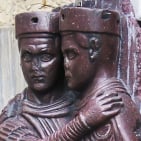Composite glyphs
Comments
-
@PaulMiller
Therefore, in addition to distinguishing the various types of compound diacritics (it is clear that, if we stack the diacritics, circumflex + acute / severe occupies much more vertical space than short + acute / severe) - do you distinguish even if these diacritics fall on upper or lower case?
0 -
mauro sacchetto said:@PaulMiller
Therefore, in addition to distinguishing the various types of compound diacritics (it is clear that, if we stack the diacritics, circumflex + acute / severe occupies much more vertical space than short + acute / severe) - do you distinguish even if these diacritics fall on upper or lower case?It depends on the design of the typeface and how it looks with two diacritics but usually with lower case characters that only come up to the x height there is enough room above a character to accomodate two normal sized diacritics without any problems. I don't think there are many tall lower case characters which need two diacritics.The problems arise for upper case characters with two diacritics which would not have enough room between the top of the character and 'Win Ascent' which is the limit at which Windows stops rendering the character.You can use a larger value for 'Win Ascent' but this will add more space between the lines of text in your font.1 -
Vietnamese diacritic glyphs is a matter of its own. I recommend not to judge them by the same criteria like other (Latin) multi-part dicritic glyphs. And yes they are very tricky to make. Very rewarding.
4 -
Peter Baker said:There's an interesting-looking online book devoted to Vietnamese typography, by one Donny Trương (scroll all the way down for the table of contents), which appears to address the problem of stacking diacritics pretty thoroughly.I followed that link; it was very informative. I had been puzzled by the Vietnamese examples in this thread; I had thought that when two accents were stacked, the normal practice was to always have them centered vertically.While that may have been true of the particular typefaces I had seen in use, now, thanks to that reference, I know that the other alternatives are considered fully acceptable.0
-
That's exactly my problem with anchors. A lot of accents must be finely positioned (or even reshaped) according to what base glyphs they are attached to.Thomas Phinney said:Although I am fond of anchors and automatic positioning, not every accent can be handled well in this way.
For the horn, in particular, if one is finicky about quality, positioning relative to the U is tricky, and usually the shape needs adjustment to blend into the O nicely.
Similar issues exist for the ogonek.
The cedilla and non-attached accents are generally fine with using anchors.
(Note: the horn is required for Vietnamese, and the ogonek for Polish, Lithuanian, and a number of less commonly-supported languages.)
I don't think I can have asymetrical (meaning acute and grave) accents above letters attached to the same centered anchor as symetrical ones.0
Categories
- All Categories
- 46 Introductions
- 3.9K Typeface Design
- 487 Type Design Critiques
- 563 Type Design Software
- 1.1K Type Design Technique & Theory
- 656 Type Business
- 861 Font Technology
- 29 Punchcutting
- 520 Typography
- 119 Type Education
- 324 Type History
- 77 Type Resources
- 112 Lettering and Calligraphy
- 33 Lettering Critiques
- 79 Lettering Technique & Theory
- 558 Announcements
- 94 Events
- 114 Job Postings
- 170 Type Releases
- 179 Miscellaneous News
- 276 About TypeDrawers
- 54 TypeDrawers Announcements
- 120 Suggestions and Bug Reports



